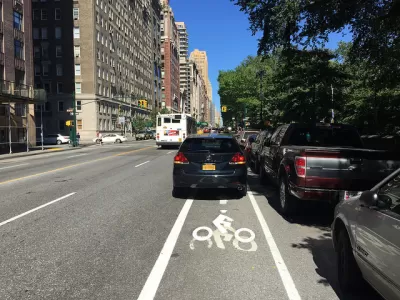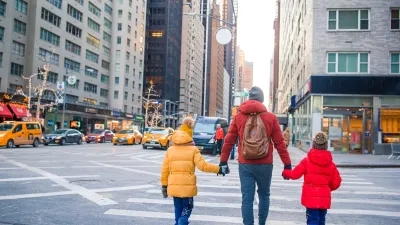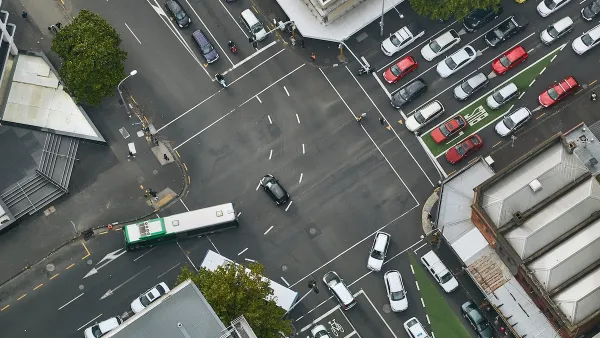Traffic safety initiatives must recognise that all vehicle travel imposes risks, and traffic reduction policies increase safety in addition to other benefits.

This article is written by Jeremy Leach and Emma Griffin, originally published by Action Vision Zero, UK, and republished here by permission.
The news that not one pedestrian or person cycling died on Oslo’s streets in 2019 came as a jolt to the countries and cities struggling to meet Vision Zero targets.
Last year, 130 people died on London’s streets including 71 pedestrians and five cyclists, according to TfL’s provisional figures. This January, in Peckham alone, three people were killed in road collisions. The UK was also one of only three European nations where pedestrian casualties rose in last decade, according to European Transport Safety Council.
So what is Oslo (and Norway that adopted Vision Zero in 1999) doing that’s so different? Is there a link between Oslo’s commitment to go car free and this fall in fatalities?
New research suggests there is. Action Vision Zero has been exploring a report by Todd Litman, from the Victoria Transport Policy Institute, that concludes that all motor traffic exposes people to danger. This means that road safety policies must do more than tackle dangerous driving and include actions for traffic reduction, such as road pricing. In doing so, Vision Zero is not just about solving road danger, but also our air quality, climate change and inactivity crises.
LESS TRAFFIC
Action Vision Zero lists “less traffic” as a policy tool for reducing casualties following the principles of Road Danger Reduction. Yet while these principles (“achieving safer roads by reducing danger at source”) are quoted in many Vision Zero plans they are rarely translated into policies for traffic reduction.
 As an example, London’s ambitious Vision Zero Action Plan, published in 2018, sets traffic reduction as a “guiding principle” and refers to the virtuous circle of road danger reduction (see image).
As an example, London’s ambitious Vision Zero Action Plan, published in 2018, sets traffic reduction as a “guiding principle” and refers to the virtuous circle of road danger reduction (see image).
But traffic reduction doesn’t then make it into the Action Plan’s “five pillars of action”: safe speeds, safe streets, safe vehicles, safe behaviours, and post-collision response.
The same is true in New York’s Vision Zero plan which focus on traffic violations and road design without outright mention of the impact of traffic volumes.
Similarly, Sweden, which pioneered Vision Zero in 1997, has also been accused of being too car centric, with the safety of people in motor vehicles improving at the expense of people walking and cycling.
MAKING THE LINK
The omission of traffic reduction may come down to a lack of research. There is a mass of evidence that shows the impact of safe speeds, safe road design, safe vehicles and safe behaviours on road casualties, but far less on the impact of traffic as a whole… until now.
Todd Litman’s 2019 report, A New Traffic Safety Paradigm, analyses traffic statistics and research to reveal that exposure, in terms of total vehicle travel, is a risk factor to those both inside and outside the vehicles.
For example, when fuel prices rose between 2004-13 in the United States, people drove less and deaths went down. Then when fuel prices decreased after 2014 and traffic levels rose again, so did deaths. He quotes research that shows “each 1% increase in per capita Vehicle Miles Travelled (VMT) is associated with a 0.55% increase in traffic deaths (Yeo, Park and Jang (2015)).
Traffic reduction appears to have the potential for a greater impact on casualties. In his examples on the impact of a fall in VMT, Litman cites:
- Studies by Chi, et al. (2010a, 2013 and 2015) – a 1% reduction in total VMT reduces total crashes more than a 1%.
- 2015 research from Lancaster University found that following the introduction of the London’s congestion charge in 2003, vehicle travel declined 14% and traffic casualty (injury or death) rates declined by 25%.
He concludes from this on traffic reduction that “each 1% reduction in total vehicle travel should reduce total casualties between 1.0% and 1.7% (i.e. a policy that reduces total vehicle travel by 10% is likely to reduce injuries and deaths by 10-17%)”.
Litman’s research focuses on US examples, but the principle applies in a European context. In the UK, the huge promotion of driving since 2010 has coincided with an increase in traffic volumes and an increase in deaths on roads. In London, research by Lancaster University showed that the introduction of the congestion charge in 2003 also resulted in a “substantial” reduction in traffic casualties and fatalities, both in the charged area and hours and in adjacent areas and times.
The link seems intuitive. The more vehicles that pass someone cycling or a person trying to cross a road, the more chance of a collision. Could this explain why women, who on average cycle more slowly, have higher near-miss rates than men? (see Rachel Aldred’s Near Miss Project (2015)) The slower you cycle, or the slower you cross the road, the greater your exposure to motor vehicles?
Litman’s conclusion is that traffic safety initiatives, such as Vision Zero, should ditch old assumptions that driving is “generally safe”, thereby favouring policies that target special risks. Instead they must recognise the risk of all vehicle travel and therefore the safety benefits of traffic reduction policies.
TRAFFIC REDUCTION POLICIES
This research suggests that the following traffic reduction strategies can provide large safety benefits:
- Transportation pricing — partly as a disincentive, but also to get motor traffic to pay more fairly for their impact on the road network, the environment and our health.
- Land use — stopping building new housing in locations away from our urban centres; focusing retail development on our town centres rather than out-of-town shopping.
- Public transport — providing affordable, accessible, integrated alternatives to the car.
- Infrastructure changes — schemes such as low-traffic neighbourhoods make walking and cycling more attractive and driving a little less convenient.
VISION TWO POINT ZERO
For too long the UK’s road danger crisis has struggled to be at the forefront of politicians’ and communities’ minds. This might be because initiatives like Vision Zero have had too narrow a focus. But by including traffic reduction as a tool, Vision Zero can broaden its reach to tackle issues such as traffic congestion, inactivity, air pollution, and the climate emergency. With traffic reduction in its armoury, suddenly Vision Zero is no longer operating on its own.
More key findings
Todd Litman’s research is available to download here. Some key statistics and conclusions are summarised below.
THE COSTS OF DRIVING
- A comprehensive study of 14 industrialised countries found that a 10% gasoline price decline caused road fatalities to increase 2.2% (Ahangari, et al. 2014).
- A 10% fuel price increase typically reduces traffic deaths by 3-6%. The report estimates that removing global fuel subsidies would reduce approximately 35,000 annual road deaths worldwide (Burke and Nishitateno (2015)).
- Each 10% fuel price increase is estimated to reduce total traffic deaths by 2.3% (Grabowski and Morrisey (2004 and 2006)).
PLANNING
- Road casualty rates are much lower in compact neighbourhoods with more walking cycling and public transport, than in sprawled, automobile-dependent areas.
- In the US, the most compact and multi-modal U.S. communities, often called Transit Oriented Developments, generally experience two to three deaths per 100,000 residents, an order of magnitude lower than the 20-40 deaths per 100,000 residents that occur in the most sprawled, automobile-dependent communities.
- Per capita traffic fatality rates increase with sprawl, apparently due to a combination of increased vehicle travel, higher traffic speeds and slower emergency response times (Yeo, Park and Jang (2015)).
- An urban area’s per capita crash rates decline with more job-housing balance, more polycentric design, increased population density and less low-density sprawl, improving transportation network connectivity and more public transit facilities (Najaf, et al. (2018)).
PUBLIC TRANSPORT
- Crash rates also decline with increased use of public transport in built-up areas (Karim, Wahba and Sayed 2012; Scheiner and Holz-Rau 2011).
INFRASTRUCTURE CHANGES
- Infrastructure improvements that enable more walking and cycling are also linked to lower crash risk.
- More compact communities had significantly higher use of public transport, slightly higher total crash rates, but much lower fatal crash rates than sprawled communities: each 10% increase in their compact community index is associated with a 0.4% increase in total crashes, but a 13.8% reduction in traffic fatalities (Hamidi, et al. (2015)).
FULL STORY: It’s Not Just Speed that Kills. New Research Recognises the Danger of all Traffic on Our Streets.

Planetizen Federal Action Tracker
A weekly monitor of how Trump’s orders and actions are impacting planners and planning in America.

Chicago’s Ghost Rails
Just beneath the surface of the modern city lie the remnants of its expansive early 20th-century streetcar system.

San Antonio and Austin are Fusing Into one Massive Megaregion
The region spanning the two central Texas cities is growing fast, posing challenges for local infrastructure and water supplies.

Since Zion's Shuttles Went Electric “The Smog is Gone”
Visitors to Zion National Park can enjoy the canyon via the nation’s first fully electric park shuttle system.

Trump Distributing DOT Safety Funds at 1/10 Rate of Biden
Funds for Safe Streets and other transportation safety and equity programs are being held up by administrative reviews and conflicts with the Trump administration’s priorities.

German Cities Subsidize Taxis for Women Amid Wave of Violence
Free or low-cost taxi rides can help women navigate cities more safely, but critics say the programs don't address the root causes of violence against women.
Urban Design for Planners 1: Software Tools
This six-course series explores essential urban design concepts using open source software and equips planners with the tools they need to participate fully in the urban design process.
Planning for Universal Design
Learn the tools for implementing Universal Design in planning regulations.
planning NEXT
Appalachian Highlands Housing Partners
Mpact (founded as Rail~Volution)
City of Camden Redevelopment Agency
City of Astoria
City of Portland
City of Laramie





























